FACE Reveal
In the last article we dug into the YM3812 registers and how to manipulate them an electrical level. Today we are going to build up the first part of the schematic—just enough to get sound working through a microcontroller.
Whenever building on a new platform, What’s the first thing you implement? Hello World. It’s a great starting point that ensures everything works—the hardware, the development toolchain, etc. We need an equivalent project for our YM3812 that uses sound instead of text on the screen. We need… a FACE reveal! (you know… play an F major 7th chord… F A C E… yeah… woof… #DadJokes 🙄). OK but seriously… to play a note on this chip, we need working hardware, a library that interfaces with the chip, a properly configured voice, and the ability to turn on/off a note at the right frequency. This is going to be an epic journey… and it’s going to take two articles to complete. In this article, we will start with the hardware and schematic, and then upload the code from the GitHub repo using the Arduino IDE. Then in the next article, we will look into the code in a bit more detail to see exactly how it’s working.
The Components
In the spirit of starting small, I’ve pulled together a simple implementation of the YM3812 hardware. Technically, you could simplify this further—interfacing the full 8-bit data bus directly with the microcontroller, or having the microcontroller produce the 3.58 MHz clock. But we are going to need some of those pins down the line and this all fits on a single breadboard. Let’s take a look at our cast of silicon characters.
AVR128DA28 Microcontroller
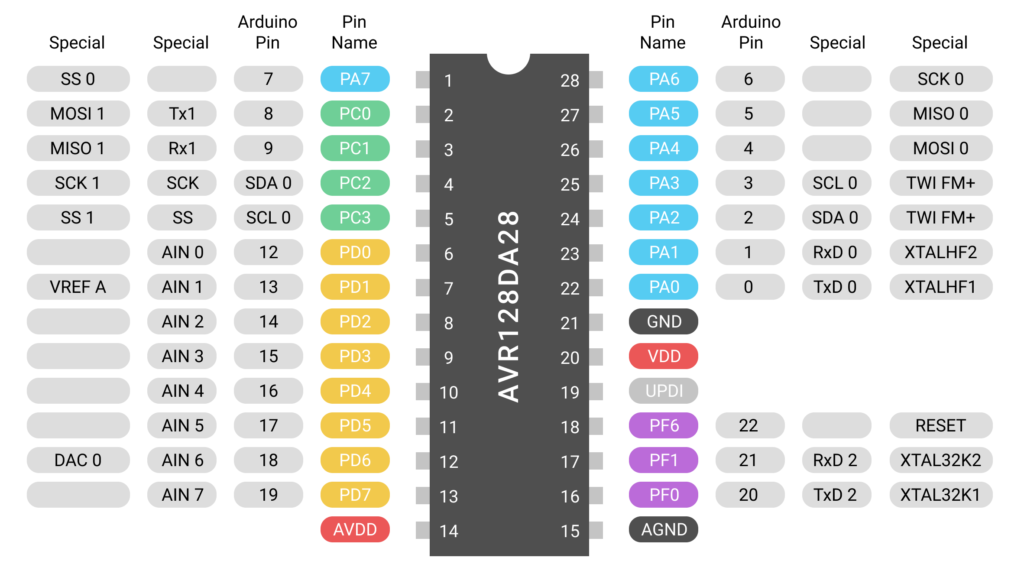
I like to think of the AVR128DA28 as an Arduino Nano, but in chip form—and far more capable. This chip sports:
- 128kb of program memory and16kb of ram
- 10 AD converters, and a DA converter
- I2C, SPI, UART, and even 4 hardware serial ports
- Operating voltage of 1.8v to 5.5v
- Internal auto-tuned 24 MHz oscillator
- UPDI programing & Arduino IDE Support
- And sooooo much more…
All in an itty bitty 28pin DIP package. There are even more powerful surface mount versions of the chip as well, but this will give us plenty of oomph in our project. I have to give a shout out here to Robbie Langmore from Tangible Waves for introducing me to these microcontrollers. In a world of chip shortages, there are still ~300 in stock at mouser—as of writing this.
74HC595 Shift Register
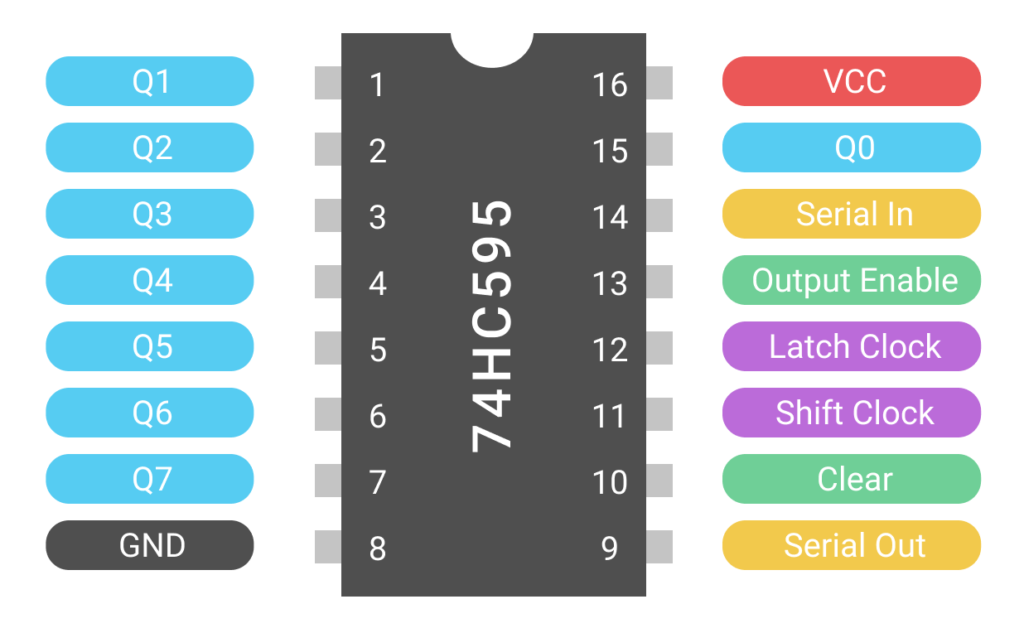
The 74HC595 shift register is next in our lineup. This chip converts the serial output from the AVR’s SPI bus and converts it into the 8-bit parallel bus that bus required by the YM3812.
YM3812 OPL2 Sound Processor
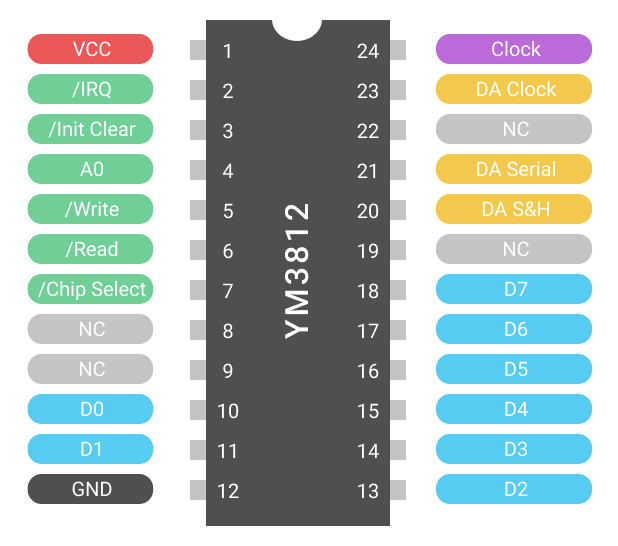
If you are reading this article and wondering what this chip does, then I highly recommend reading part one of this series. Other than some decoupling capacitors, the YM3812 requires a a 3.58Mhz crystal oscillator.
Y3014B DAC
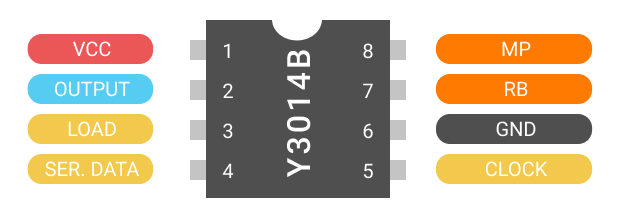
Unlike some of the other YM sound processors, the YM3812 does not have an analog output. Instead, it needs to be paired with the Y3014B 10-bit Digital to Analog Converter. This chip takes a serial data stream coming from the YM3812 and converts it into an analog output. The Y3014B requires a voltage of 1/2 VCC on pin 8 (MP) to bias the output signal (pin 2) around. Fear not though, it produces its own reference voltage on pin 8 (RB), but you still need to buffer that voltage using an operational amplifier. Also, buffering the output signal (pin 2) with an operational amplifier is another solid plan.
TL072 / LM358 OpAmp
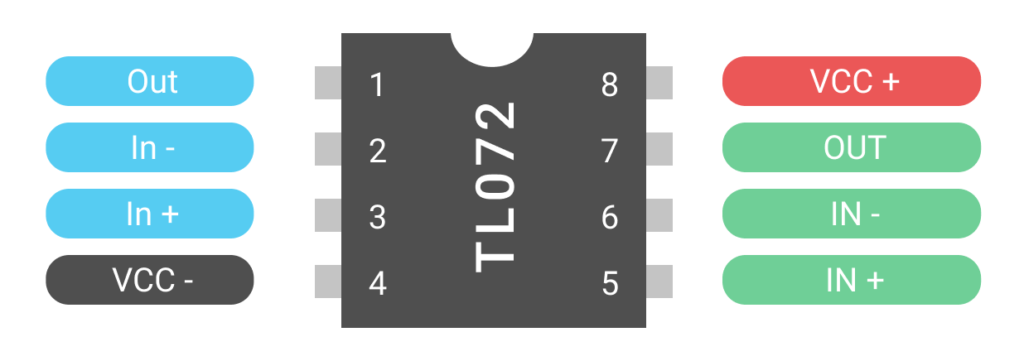
Did somebody say operational amplifier? OpAmps are the workhorses of Eurorack Modules and Analog Circuitry in general. Unless it’s a passive attenuator, odds are, there’s going to be 1 or maybe 10 of these versatile building blocks. In our case, will use these to buffer the reference voltage and output signal generated by the Y3014B.
Other Parts
After the ICs, there’s only a handful of other parts.
- The six .1uF capacitors provide decoupling for the ICs
- The two 10 uF capacitors stabilize the reference voltage on the Y3014b
- And the 4.7 uF capacitor provides capacitive coupling on the audio output
- The 100k resistor ties the output capacitor to ground and the 1k resistor ensures appropriate output impedance
- The 1N4148 signal diode converts the single-wire UDPI pin into separate Tx/Rx pins that attach to an FTDI cable
- Lastly, a micro-switch provides a reset button for the AVR microcontroller.
Schematic Time!
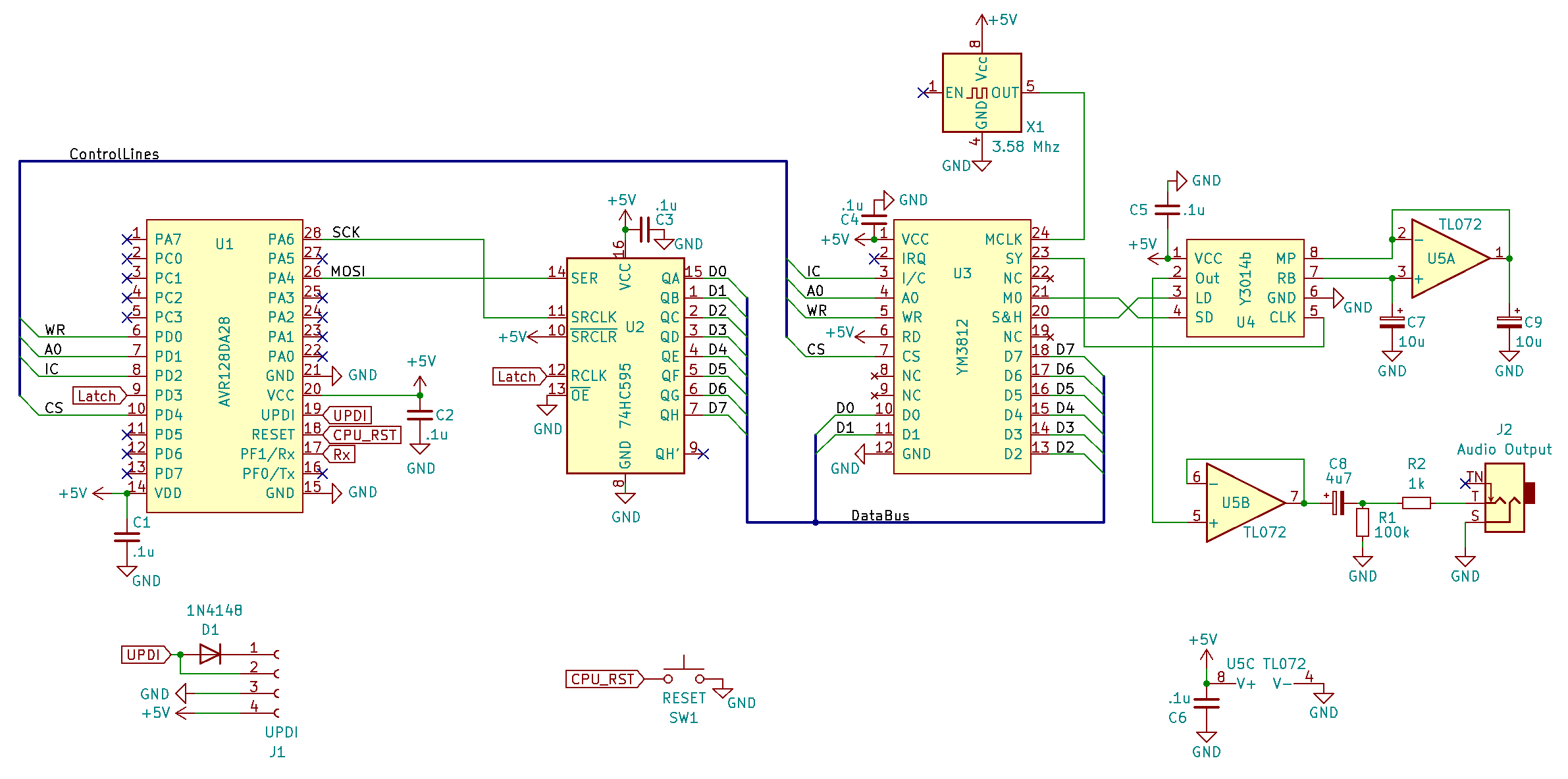
Microcontroller Connections
Now that we’ve talked through how the pieces work, the schematic should seem pretty straightforward. The Clock (pin 26) and Data (pin 28) of the SPI bus of the AVR128DA28 connects to the Serial Data (pin 14) and Shift Clock (pin 11) inputs on the 74HC595 shift register. PortD-3 (Pin 9) on the microcontroller connects to the Latch Clock (pin 12) on th 74HC595 and latches the output of the register. This sends the 8 Data Bits (pins 15, 1-7) to the YM3812 Data Inputs (pins 10-11, 13-18).
PortD 0, 1, 2 and 4 (pins 6, 7, 8, 10) on the microcontroller connect to the four control lines of the YM3812—Write (pin5), A0 (pin 4), Initialize/Clear (pin 3), and Chip Select (pin 7) respectively. On the YM3812, tie Read (pin 6) high to prevent rogue reads. IRQ (pin 2) can be left floating in the breeze.
Sound Processor & DAC Connections
The Output of the 4.58 MHz Crystal Oscillator flows in to the Master Clock Input (pin 24) on the YM3812. Enable (pin 1) on the oscillator should float. Tying it to ground disables the clock output.
The Serial Data and Clock output pins on the YM3812 connect to the Serial Data and Clock input pins on the Y3014B and transfers the raw sound data to the DAC. Sample & Hold (pin 20) on the YM3812 connects to the Latch (pin 3) on the Y3014B, and updates the analog value of the output.
The Y3014B produces a reference voltage of 1/2 VCC on RB (pin 7) which the TL072 then buffers and sends back to the output bias control pin MP (pin 8) on the Y3014B. C7 and C8 stabilize the reference voltage.
The Analog Output signal of the Y3014B (pin 2) get buffered through another operational amplifier on the TL072 before passing through a coupling capacitor (C8) to remove the DC bias. A high value resistor (R1) ensures our output stays centered at ground, and R2 ensures our output remains at a 1k impedance.
The Other Stuff
Of course all of the ICs require decoupling capacitors on their power pins (C1 – C6). And a reset button connects the Reset Line (pin 18) of the AVR128DA28 to ground. As far as I can tell, the reset button doesn’t require a debouncing filter, you can just directly connect it.

Lastly, the AVR128DA28 can be programmed through a one-wire Universal Programming & Debugging Interface. If you don’t have one of those programmers, you can use an FTDI to USB connector. There are many variations of this connector, some include the RTS/CTS lines (which we don’t use) and some don’t. Also, there are a couple of color variations of the wires on the connector. Here is an alternate color scheme that I have seen:

FTDI Cable with Alternate Color Combination
Starter Code
Our circuit isn’t going to do much without a bit of code. We need to program the microcontroller to see if everything works. As it happens that I created a simple library on my GitHub for just that purpose. I’ve trimmed it down to its basic elements and added loads of comments to make things as readable as possible. Feel free to download and play around with it, and in the next video we’ll dive into exactly how the code works.
Note, to get the YM3812_Breadboard.ino file to work, you will need to create a “YM3812_Breadboard” folder in your Arduino folder and then copy YM3812_Breadboard.ino, YM3812.h, and YM3812.cpp into it.
Programming the Micro
Assuming that you chose to use an AVR128DA28 as your microcontroller, you’ll need to install the DxCore in your Boards Manager. DxCore is an open sourced library written by Spence Konde that allows you to use the AVR128 line of microcontrollers in the Arduino IDE. There are detailed installation instructions on the GitHub, but this should at least get you started.
First we need to add a URL to the Additional Boards Manager URLs. To do that, open the menu: Arduino > Preferences:
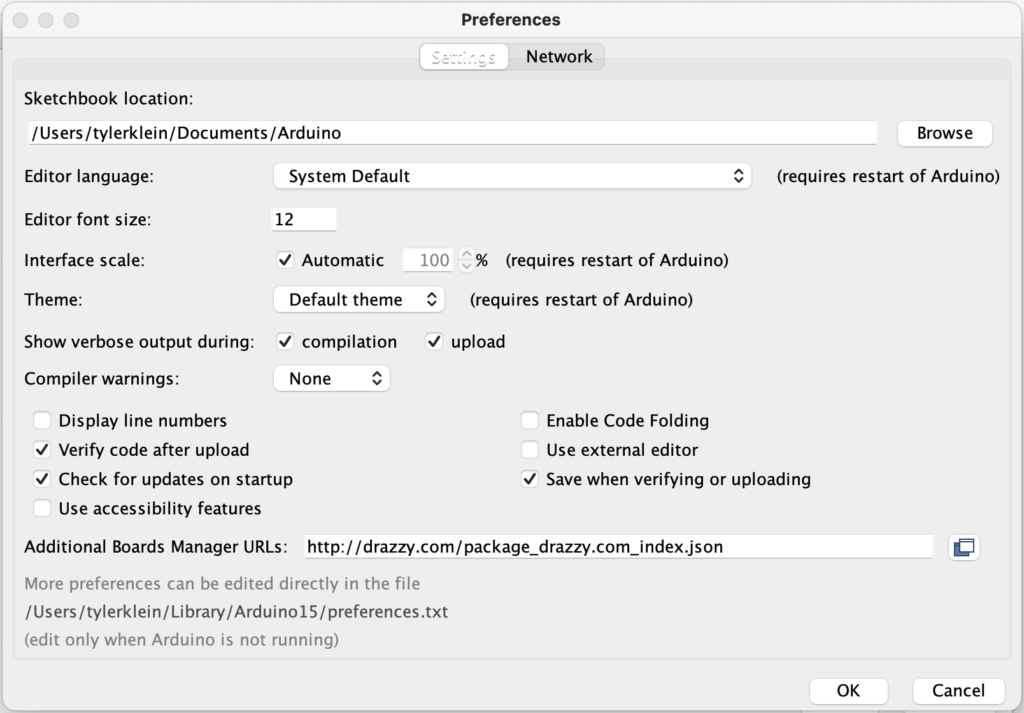
Enter the url, http://drazzy.com/package_drazzy.com_index.json in the Additional Boards Manager URLs text box as shown above.
Then, locate the boards manager in Tools > Boards:… > Boards Manager
Search for DxCore and locate a package that looks similar to the one below:
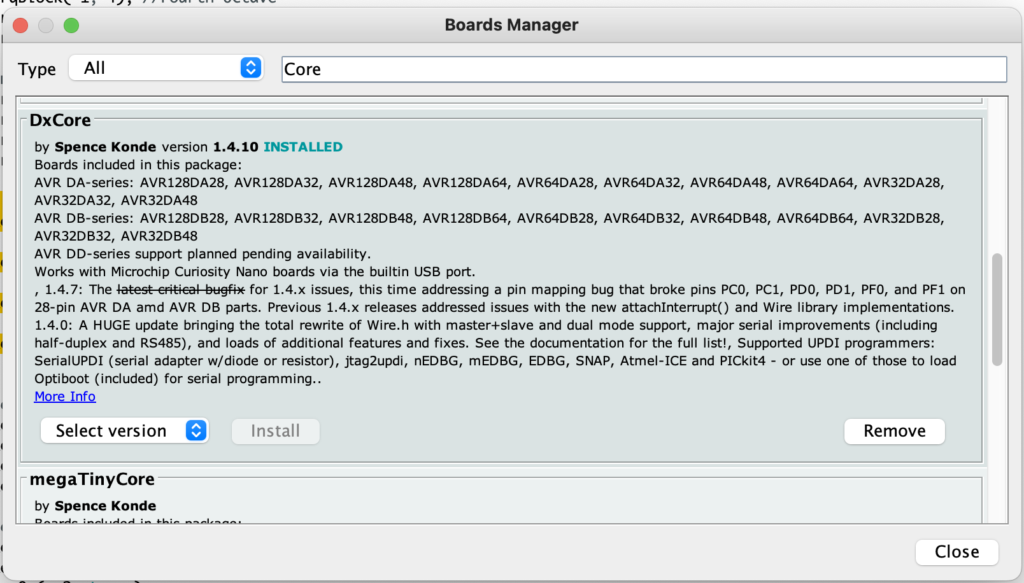
After installing the DxCore boards library, you should be able to select the AVR DA-series (no bootloader) from the board menu. Also, select AVR128DA28 as the chip, and 24 MHz Internal as the Clock Speed.

The programmer that worked best for me was SerialUPDI – 230400 baud. It’s quite fast.
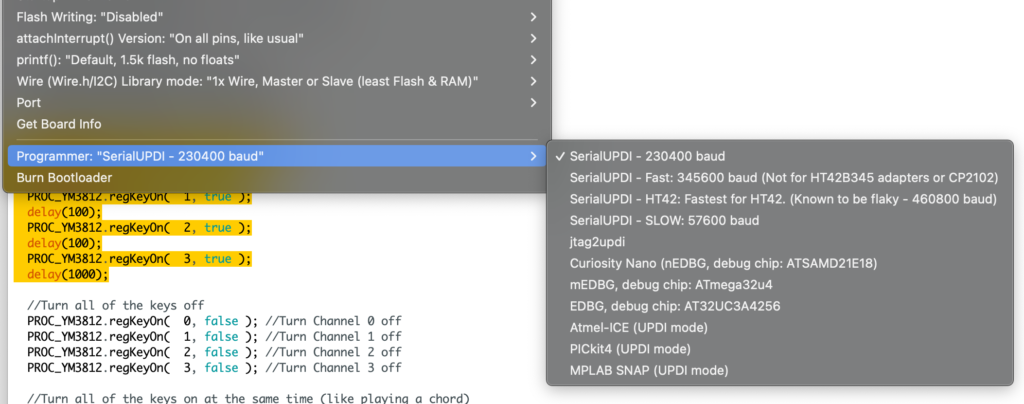
Now, just connect your FTDI cable as described in the schematic section of this article. And fingers crossed your program should upload directly into the micro. If it doesn’t… check that the Tx/Rx pins aren’t swapped—I’ve done that a few times.
Final Thoughts
With any luck, you have now experienced the total exhilaration of getting the YM3812 to generate that F Major 7 chord! Realistically, ANY sound at this point is great, because it shows that the hardware is working. If you got everything working, feel free to leave a comment. Similarly, if you see any issues in the schematic, let me know. After all, I’m still learning too!
In the next article, we will look through the code in detail.
Errata
- In the schematic, the labels on the SPI Clock and MOSI lines were swapped. Thank you to Peter Hesterman for catching this one!

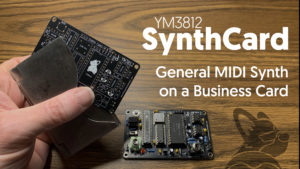
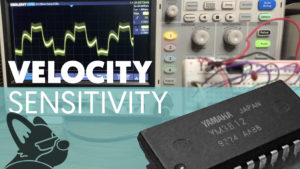
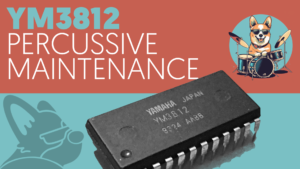
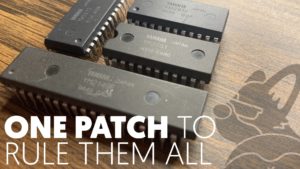
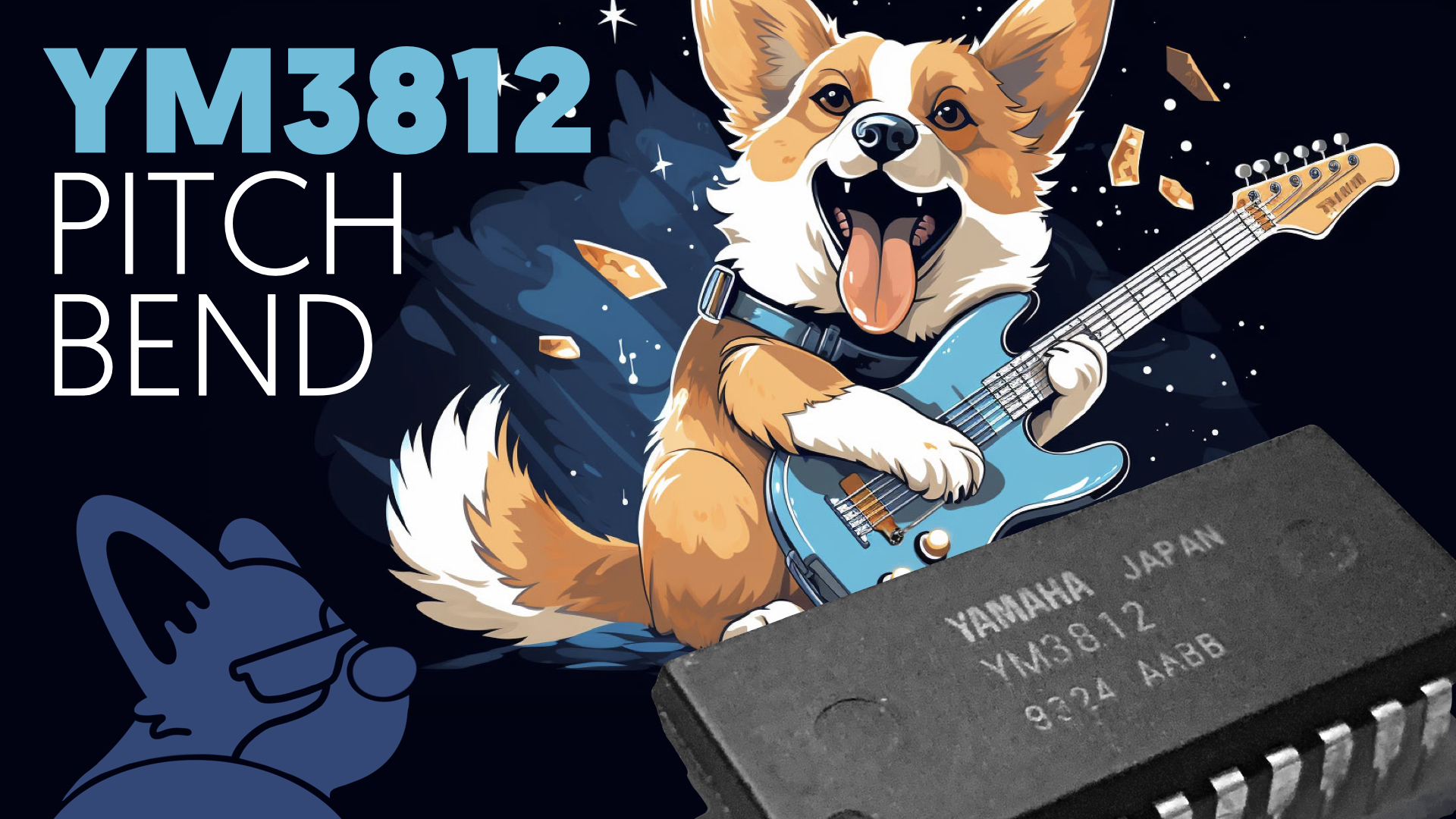
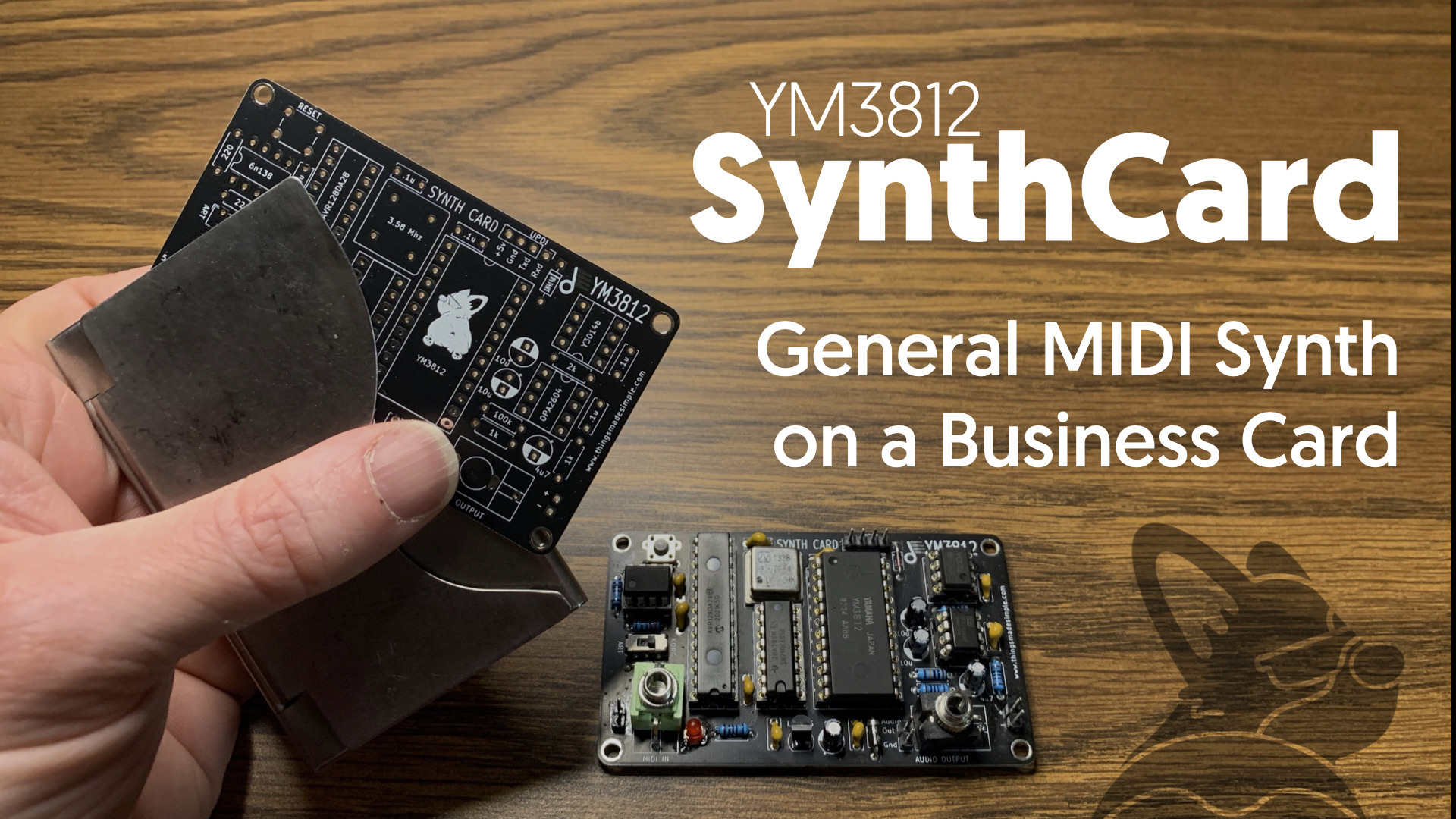
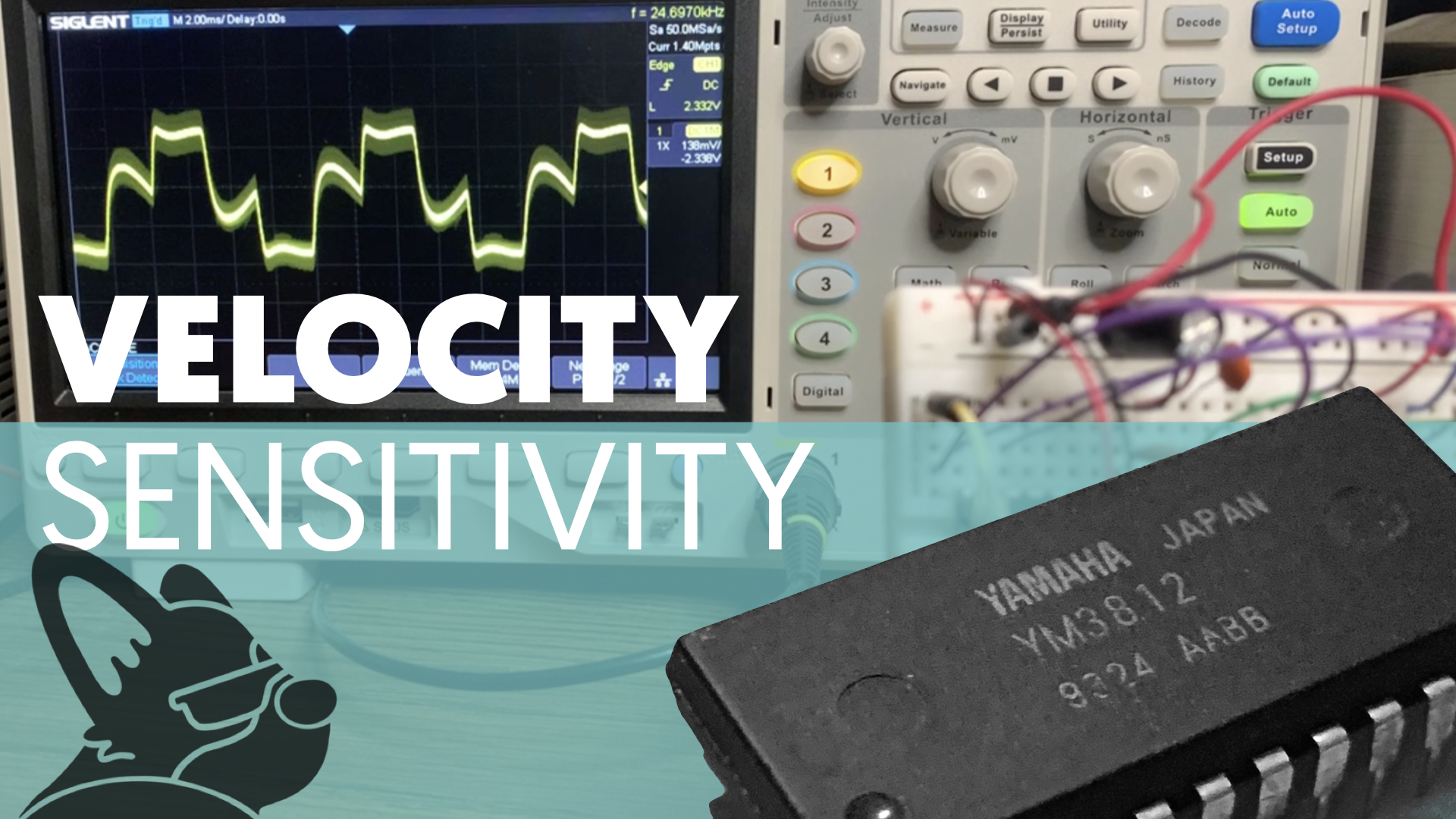
19 thoughts on “YM3812 Part 2 – FACE Reveal”
Peter Hesterman
Tyler,
This is really a great project…thanks for all the work you’ve put into it!
I put in an order to mouser for an AVR128DA28, but I couldn’t wait to get started, so I substituted an Arduino Nano and I’m happy to say that with the Nano I’ve successfully generated the Fmaj7 chord. Unfortunately, I’ve not been so lucky with the AVR128DA28. I’ve been able to program it (the Blink sketch works, at least); the YM3812_Breadboard.ino sketch loads successfully, too, but when I replace the Nano with it and wire it up, nothing. I’ve rechecked the wiring and power circuit many times, so I’m a bit flummoxed by this. I suppose I can go back to the Nano, but I’d wanted to follow along as closely as possible with what you’re doing in the articles.
Any suggestions?
Thanks!
Peter
Tyler in reply to Peter Hesterman
Hey Peter, so glad to hear you are following along! Couple things to try:
I’ve noticed that sometimes the AVR locks right at the beginning, but if you hold the reset button for a second or two and let go it starts working. I have no idea what’s causing that but it seems to work after a couple of tries. If you added the debug light, then it should be off when the thing starts up. If it is on, hit the reset button a couple of times.
Another thought, did you change the sendData or setup functions to work with the pins on the NANO? You might have to change those back.
Anyway, let me know if the issue continues. The NANO works for now, but once we get to drums, you will need more than 2k of RAM.
-Tyler
Peter Hesterman
Tyler,
Thanks for your reply! I’ve made a bit of progress, but still no sound, unfortunately. Mostly, when I apply power to the circuit, the debug light comes on solid…pressing, or pressing and holding, the reset button seems to have no effect, however. Occasionally, when I power up though, the debug light pulses in the rhythm of the Fmaj7 arpeggio, which seems right–I just don’t hear anything. I don’t know if there’s a fault in my breadboard or some other component, but I’m going to start fresh with some new parts. I’ll report back.
Peter
Tyler in reply to Peter Hesterman
One other thought that I’ve been meaning to try… maybe see what happens if you use an older version of the DXCore library. I’ve noticed that the latest had some issues and ended up going back a version. But I think even that version might not play well. Maybe roll back a couple versions and see if that helps.
Peter Hesterman
Tyler,
Well, I got it working. Apparently, every time I wired it up for the Nano I connected SCK and MOSI correctly, but I must have consistently reversed those two connections whenever I hooked up the AVR. Also, after I switched to USB power instead of 9v battery power through a 5v regulator, the reset button started working correctly (I wired it like in the AVR data sheet, too). I also discovered that the program works with DXCore versions 1.45 up to the latest version (1.56). So, finally, I’m ready to move on to Part 3!!
Thanks,
Peter
Tyler in reply to Peter Hesterman
Awesome! Glad to hear it is working! Should have an update in a week or so… next up, percussion! 🙂
Peter Hesterman
I just realized why I kept mis-wiring the AVR! On your schematic, SCK and MOSI are switched…SCK should be on pin 28 and MOSI on pin 26. I wish I would have checked this against the pinout diagram sooner!
Tyler in reply to Peter Hesterman
/facepalm. You are totally right! Thank you for catching that. I will get that updated here pronto.
Tyler
Ok, schematic is updated. It looks like it was just the labels, the wires themselves go to the correct spots. Again, thanks for the catch!
Joshua
Is it possible to use a Teensy 2.0 with this? I am trying to use the AVR128 but I am unable to get dxcore in my arduino IDE, when I add the URL to preferences and open boards manager I get an erro downloading http://drazzy.com/package_drazzy.com_index.json message pops up. I even tried using Ardunio IDE 1.8.15 like yourself. When I try to upload the code to the Teensy 2.0 I get an issue with portd.outclr.
Man I really want to follow along, I have dreamed of doing a project like this. Would love to do the RP2A03 someday, but I am hitting so many roadblocks. Argh.
Tyler in reply to Joshua
Hey Joshua,
This definitely won’t compile directly for a teensy. The Teensy labels their pins differently, so you will have to change any references to PORTD, etc. to correspond to the correct pins on the Teensy. You could probably replace them all with digitalwrite commands to the appropriate pins. I didn’t do that here because it is a bit slower. One note of caution on the Teensy 2.0, it only has ~2K of RAM, and you will definitely hit the limit of that in part 6.
I poked at that URL a bit and it looks like the server might be down. Take a look at the installation instructions on the DxCore Github. They go through a manual installation process that might work. https://github.com/SpenceKonde/DxCore/blob/master/Installation.md
Tyler in reply to Joshua
It looks like the drazzy.com site was down for a short time, but they got it back up within a day or two. You should be able to get the AVR128 dxcore board libraries now. Good luck!
Manuel Perales
Hi, I’m Manuel Perales, from Seville (Spain).
Thanks for these greats posts and videos. I’m planning to buy a YM3812 chip to build a simple synth, probably with a different microcontroller. Looking to the schematic, I don’t understand why do you use a 74HC545, having in mind that there are many pins unused in the AVR. Wouldn’t it be better to connect directly in parallel, lets say port 1 of the AVR to the data bus pins of the YM?
Tyler in reply to Manuel Perales
Hey Manuel, Great question! I ended up using the 74HC545 to keep those extra pins free for other sections of the module. Eventually, we will need to add keys, a screen, a rotary encoder, and chip select lines for separate sound chips. In one of my earlier versions of the project, I just used the 8 pins of PORTD as the data bus, but then had to switch over to the SPI bus to save pins.
Nick
Hi Tyler,
I can’t compile the code in latest version of Arduino IDE. I have flashed an Arduino Uno Rev3 (Elegoo version) using AVRDude V7.3 with jtag2updi programmer and all looks good (both AVR128DA28 and jtag2updi appear to be included in the current .conf file so should work). In theory I just need .hex file from compile but IDE is throwing a compilation error: stray ‘\302’ in program on your code. I’ve tried breadboard and Article 8 versions. I also searched the .cpp and headers file for all whitespace gremlins but that hasn’t solved the problem. Any ideas? Many thanks.
Nick
Update – it works. My bad – the code is fine and for some i had a corrupted file. Also AVRDude works great using the uno as a programmer. This is ace work!!
Tyler in reply to Nick
Glad you got that sorted! I used to use an Arduino micro as a programmer too, but then switched over to the FTDI cable after I fried the Arduino by accidentally shorting some pins. So far I haven’t killed the FTDI cable. [fingers crossed]